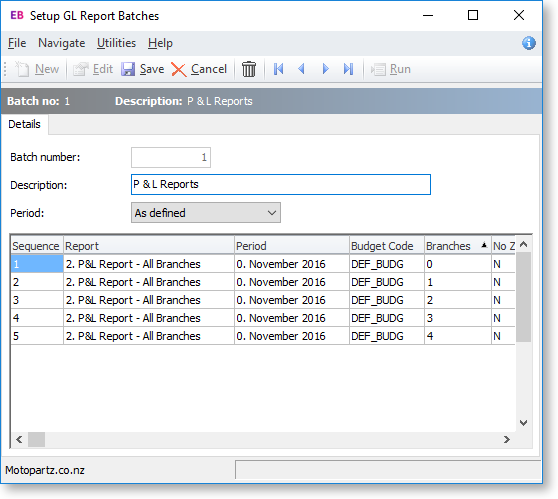General Ledger Report Batches
Reports > General Ledger Reports > Setup GL Report Batches
The GL Report Batches utility enables multiple GL Reports to be batched together and scheduled to run at a convenient time. A GL report batch could be a collection of different reports such as P&L and balance sheet, but may also include repetitions of the same report with different parameters. An example of this repetition could be multiple occurrences of P&L by branch report where there is one for each branch.
Batches can be run via the user interface or run from a command line prompt. The latter allows scheduling of a batch using an external scheduler such as the “AT” command provided with Microsoft Windows. The batch can therefore be run with no user interaction.
GL reports may also be directed to file rather than printer. For example, they may be written directly to PDF files for publication to Adobe Acrobat reader. The system automatically takes care of any output dialogues to achieve this, and so can be run without user interaction.
Setting up GL Report Batches
The Setup GL Reports Batch utility allows establishment of GL report batches. This is available from both the main MYOB Exo Business menu, and the Configuration Assistant.
Note: There are three profile settings that should be set before creating GL report batches, as well as additional profiles that also apply to all batches:
-
Directory location for GL Report Batch runs (Computer-level General profile)
-
Save GL report batch files as CSV (Computer-level General profile)
-
GL Report Batch output device (Clarity Form profile)
To create a GL reports batch:
-
Start the utility from Reports > General Ledger > Setup GL Report Batches.
Note: GL Report Batches can also be set up in Exo Business Config at Admin > General Ledger > GL Report Batches.
-
When a batch is selected or created, the system shows the Search tab. From here existing batches can be selected for editing or new batches created.

-
Double-click a row or click Edit to edit an existing batch, or click New to create a new batch.
-
When creating or editing a GL Report Batch, the Details tab is shown. This shows some header information to identify the batch and lists the GL reports that are contained within the batch. The grid on the Details tab lists the reports to be run, in a specific order, with specific parameters. The contents of the grid are edited directly, to set the options for each report to be run. Moving off the line or saving the batch validates each line for correct entry.

Item
Description
Batch number
On insert, this field is automatically set to the next available number but can be changed before saving.
Description
Use this field to describe the purpose of the batch, or to distinguish it from other batches.
List seq
Enter a number here to set or change the sequence that the reports (with specific parameters) are run. On insert, this is automatically set to the next available number.
Report
Select the GL Report to run from the drop-down list, which is accessed using the spacebar. This is a required field.
Period
Select the period for which the report is to be run from the drop-down list, which is accessed using the spacebar. This is a required field.
Budget code
Select the budget for which the report is to be run from the drop-down list, which is accessed using the spacebar. This is not a required field, but should be set for reports that use budget columns. To clear the field use the backspace key.
Branches
If the report is to be run using the branch numbers defined in the report then leave this field blank. Otherwise, to override the branches set up in the report, either enter a comma-separated list of branch numbers, or right-click on the grid to Select Branch(es) or press CTRL+B.
No Zero
Set this to "Y" to suppress reporting of lines that have only zero values.
Sub A/C
Set this to "Y" to report sub-accounts on separate lines. This defaults to "Y" for systems using sub-accounts.
Clarity
Set this to "Y" to view the report using Clarity instead of the usual report viewer.
Save to File
Set this to "Y" to save the report to file instead of printing it.
Printer Name
This field is used to determine what printer the report is sent to. This field is not relevant if saving to file. Leave this field blank, to use the default printer. Right-click on the grid or press CTRL+P to select a printer.
Copies
If the report is not saved to file, this field is used to determine the number of copies to be printed, and defaults to 1. This field is not relevant if saving to file.
-
The following operations are available:
-
Insert a line using the down arrow key.
-
Cancel an insert/edit using the ESC key.
-
Delete a line using CTRL+DELETE.
-
Copy a line using CTRL+L. Use this to quickly set up a batch with reports using similar parameters, for example, a batch of P&L Reports, one for each branch. This copies the selected batch line, sets its list sequence to the next available number and selects it in the grid.
-
-
Once the batch report lines have been entered, click Save to save the batch.
Additional Batch Tools
The following functions can be used from the main Setup GL Batch Reports window, to help manage the batches.
Copy (Ctrl+O)
Copies the selected batch (including lines) to a specified Batch Number.
Merge (Ctrl+M)
Merges the selected batches into the first batch selected, resetting list sequences and deleting remaining batch headers.
Run (Ctrl+R)
Loads the Run GL Report Batch utility, which runs the selected batch.
